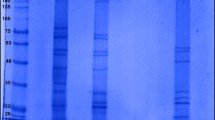Abstract
There have been a considerable number of reports in which the antigens of Anisakis simplex larvae were analyzed by using xenogenic serum. However, it is still difficult to detect specific antigens of the worm because of the high degree of cross reactivities of the antiserum with other nematodes such as Pseudoterranova decipiens larva. The recent success with monoclonal antibodies has led to the production of very specific antibodies in many areas of parasitology. In the present study, we developed hybridomas to obtain monoclonal antibodies for the purpose of detecting the specific antigens present in Anisakis larvae. In this attempt, it has become possible to detect specific epitopes of larvae, distinguishing them from other nematodes, and to analyze the corresponding antigens biochemically. It is obviously important to detect specific antigens of Anisakis larvae in the study of the taxonomic features of anisakid species and the pathological aspects ofanisakiasis. This approach may also lead to improvement in the specificity of the enzyme-linked immunosorbent assay (ELISA) as a serodiagnostic test for anisakiasis.
Access this chapter
Tax calculation will be finalised at checkout
Purchases are for personal use only
Preview
Unable to display preview. Download preview PDF.
Similar content being viewed by others
References
Kohler G, Milstein C (1975) Continuous cultures of fused cells secreting antibodies of predefined specificity. Nature 256: 495–497
Takahashi S, Sato N, Sato T, Takami T, Mukaiya M, Yagihashi A, Tsurushiin M, Hayasaka H, Kikuchi K, Ishikura H (1986) Detection of anti-Anisakis larvae antibodies using micro-ELISA method. Igakunoayumi 136: 691–692
Danforth HD (1982) Development of hybridoma-produced antibodies directed against Eimeria tenella and E. mitis. J Parasitol 68: 392–397
De Ibarra AAL (1982) Monoclonal antibodies to Leishmania tropica major: specificities and antigen location. Parasitology 85: 523–531
Gowe JS (1983) All metacyclic variable antigen types of Trypanosoma conglence identified using monoclonal antibodies. Nature 306: 389–391
Ortega-Pierres G (1984) Protection against Trichinella spiralis induced by a monoclonal antibody that promotes killing of newborn larvae by granulocytes. Parasit Immunol 6: 275–284
Epstein N (1981) Monoclonal antibodies against a specific surface determinants on malarial (Plasmodium knowlesi) merzoites block erythrocyte invasion. J Immunol 127: 212–217
Agatsuma T (1981) Electrophoretic studies on glucosephosphatase isomerase and phosphoglucomutase in two types of Anisakis larvae. Int J Parasitol 12: 35–39
Suzuki T (1968) Immunodiagnositic studies on anisakiasis. Jpn J Parasitol 17: 213–220
Asaishi K (1974) Antigenic analysis of Anisakis larva and application of fluorescent antibody technique to histological diagnosis of anisakiasis. Sapporo Med J 43: 104–120
Matthews B (1984) The source, release and specificity of proteolytic enzyme activity produced by Anisakis simplex larvae in vitro. J Helminth 58: 175–185
Ruitenberg EJ (1971) Histochemical properties of the excretory organ of Anisakis sp. larva. J Parasitol 6: 9–13
Hayasaka H, Ishikura H, Miyagi H, Ueno T, Utsumi A, Sato Y (1968) Immunologi-cal study on anisakiasis (1) on its intracutaneous reaction. J Jpn Soc Clin Surg 29: 81–87 (in Japanese)
Suzuki T, Shiraki T, Sekino S, Osturu M (1970) Studies on the immunological diagnosis of anisakiasis 3 intradermal test with purified antigen. Jpn J Parasitol 19: 1–9 (in Japanese)
Nishino T (1977) Epidemiological studies on anisakiasis. Sapporo Med J 46: 73–88 (in Japanese)
Taliaferro WH, Sarles MP (1939) The cellular reaction in skin, lungs and intestine of normal and immune rats after infection with Nippostrongyrus muris. J Infect Dis 64: 157–192
Morishita Y, Nishimura T (1968) Sarles phenomenon on Anisakis larvae. Jpn J Parasitol 17: 30 (in Japanese)
Hayasaka H, Mizugaki H, Asaishi K, Takagi R, Iwano H, Ishikura H, Aizawa M (1970) Immunological reaction of intestinal anisakiasis—especially on Sarles phenomenon. Minophagen Med Review 15: 54–58 (in Japanese)
Editor information
Editors and Affiliations
Rights and permissions
Copyright information
© 1989 Springer-Verlag Tokyo
About this chapter
Cite this chapter
Takahashi, S., Ishikura, H., Hayasaka, H. (1989). Monoclonal Antibody, Intradermal Reaction, and Sarles ‘Phenomenon. In: Ishikura, H., Namiki, M. (eds) Gastric Anisakiasis in Japan. Springer, Tokyo. https://doi.org/10.1007/978-4-431-68290-5_15
Download citation
DOI: https://doi.org/10.1007/978-4-431-68290-5_15
Publisher Name: Springer, Tokyo
Print ISBN: 978-4-431-68292-9
Online ISBN: 978-4-431-68290-5
eBook Packages: Springer Book Archive




